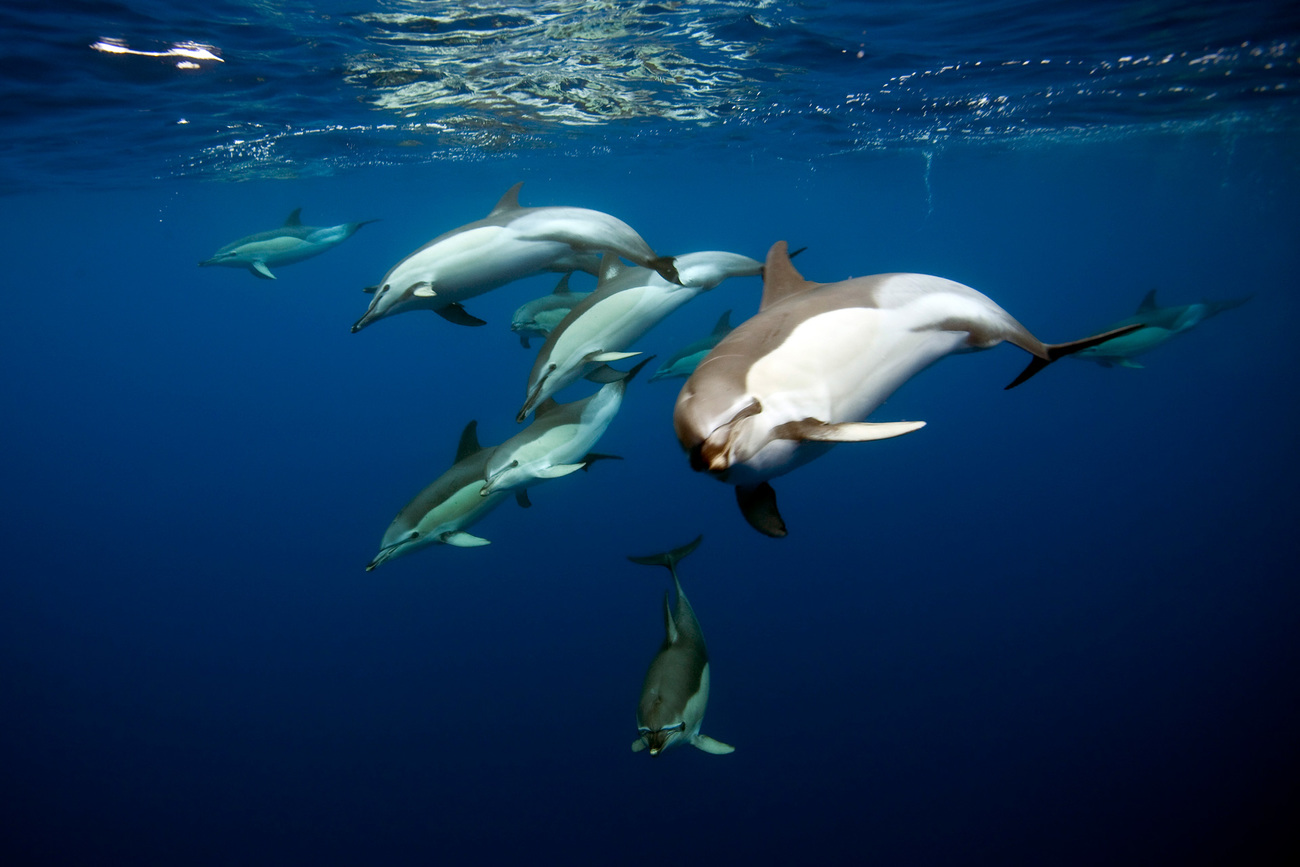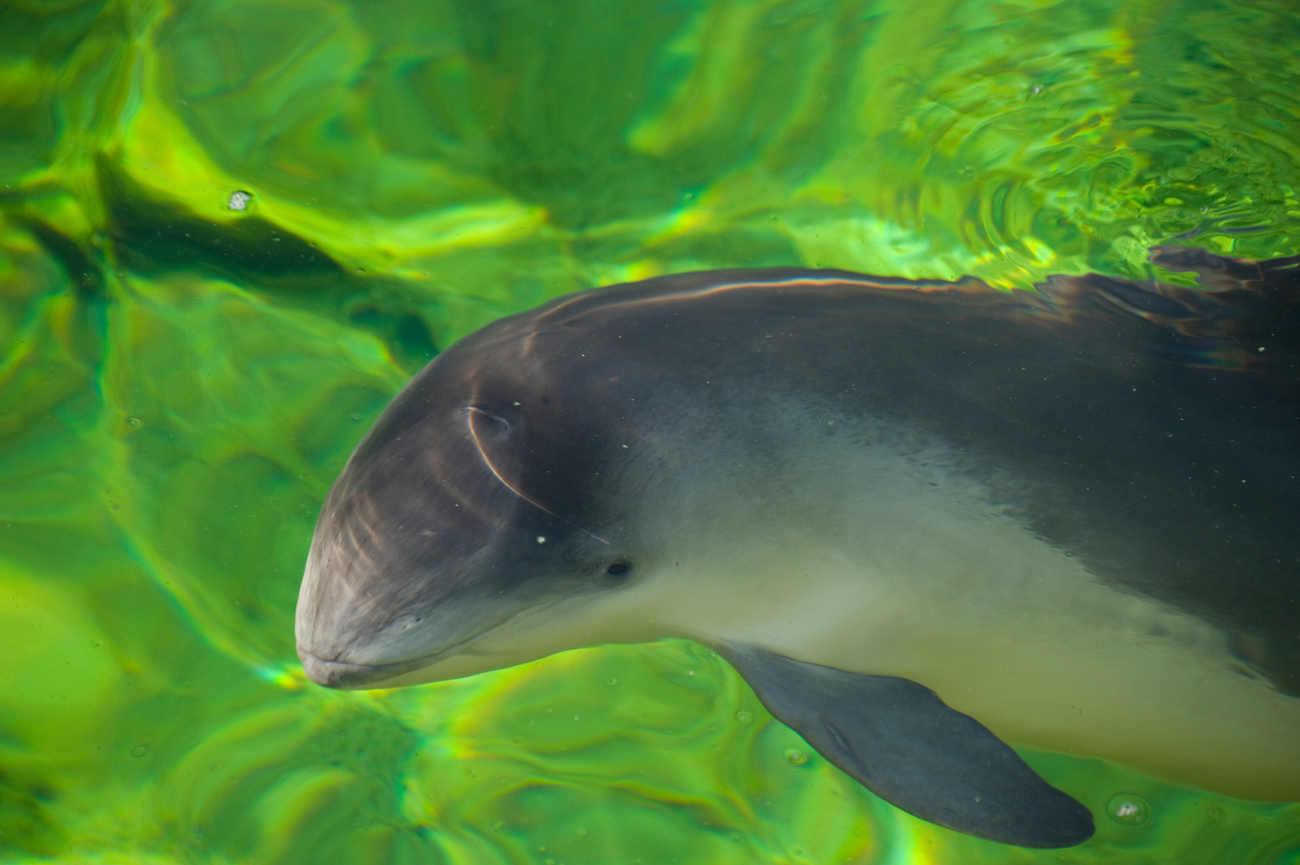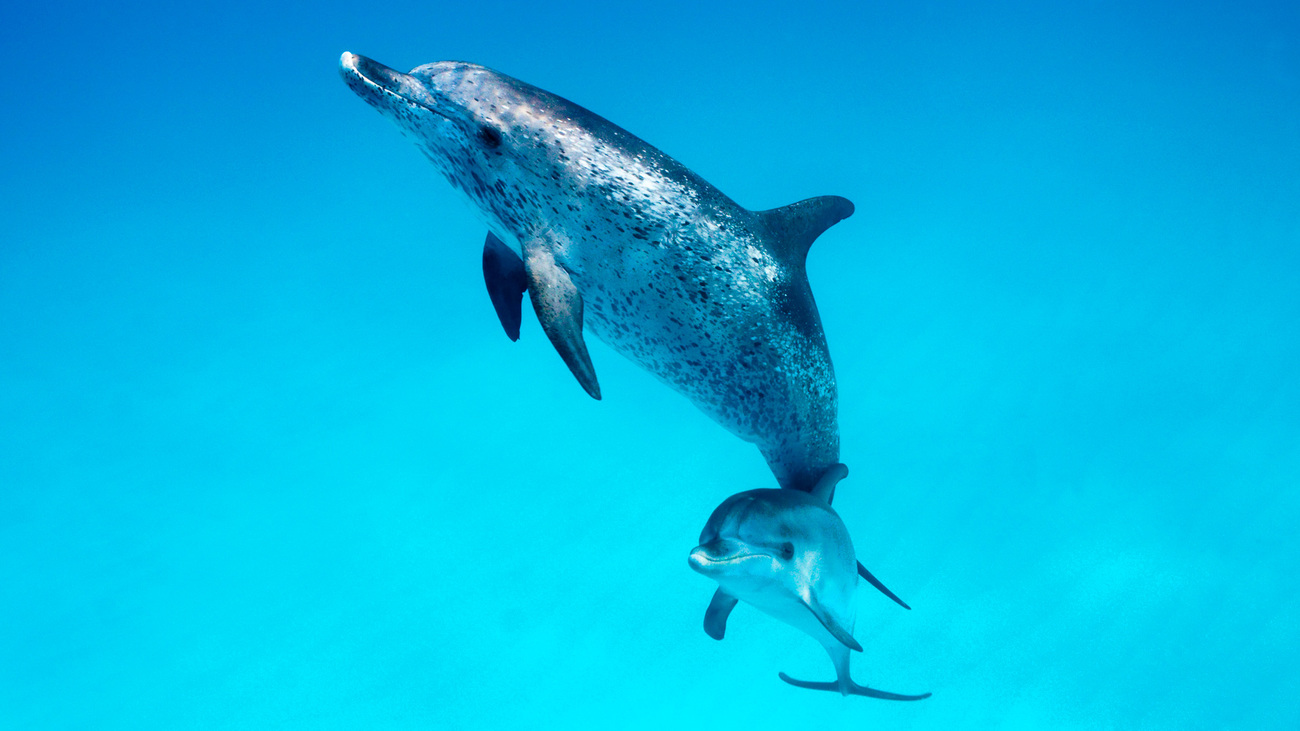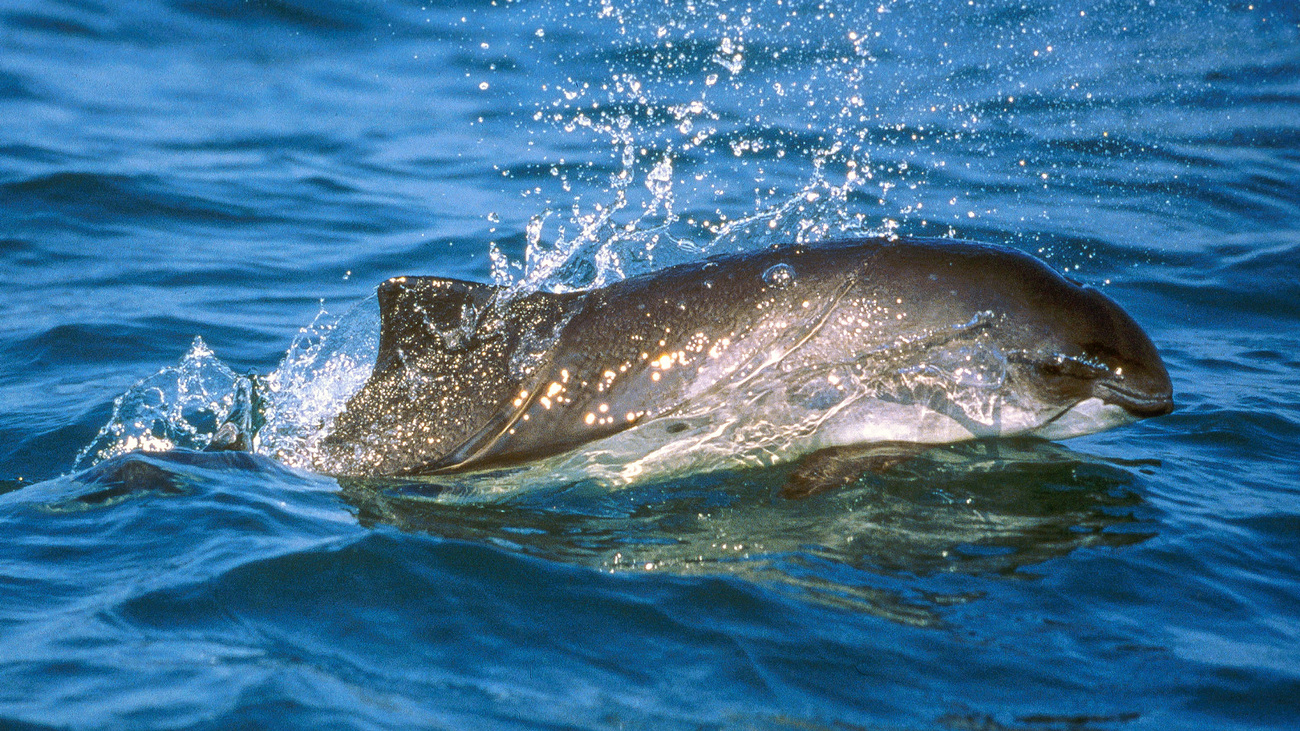Dolphins vs. porpoises: What’s the difference?
Dolphins vs. porpoises: What’s the difference?
Dolphins and porpoises are both fascinating and intelligent animals. But what is the difference between a dolphin and a porpoise? These animals share many similarities, but several key differences help us tell them apart.
Here at IFAW, we work to protect both dolphins and porpoises—and other marine mammals—from threats like entanglements, ship strikes, ocean pollution, and ocean noise.
We also rescue stranded marine mammals, releasing them back into the wild whenever possible and sharing our expertise around the world.
Read on to learn how to tell dolphins and porpoises apart and what makes each animal unique.
Is a dolphin a porpoise?
No. Dolphins are not types of porpoises, and porpoises are not types of dolphins. They are not different names for the same thing. They are separate groups of animals, each including several species.

Porpoises are members of the family Phocoenidae. There are seven species of porpoise. Though similar in size and appearance to dolphins, they are more closely related to narwhals and belugas. The seven porpoise species are:
- Harbour porpoises (Phocoena phocoena)
- Vaquitas (Phocoena sinus)
- Burmeister’s porpoises (Phocoena spinipinnis)
- Spectacled porpoises (Phocoena dioptrica)
- Indo-Pacific finless porpoises (Neophocaena phocaenoides)
- Narrow-ridged finless porpoises (Neophocaena asiaeorientalis)
- Dall’s porpoises (Phocoenoides dalli)
Dolphins belong to the families Delphinidae (oceanic dolphins), Platanistidae (Indus river dolphins), Iniidae (New World river dolphins), Pontoporiidae (brackish dolphins), and Lipotidae (containing only the possibly extinct baiji).
We also often get asked, ‘Are dolphins whales?’ The answer is yes, but it gets a bit complicated because there are two different types of whales.
Larger whales, such as blue whales, grey whales, and bowhead whales, are classified as baleen whales. Dolphins and porpoises, on the other hand, are classified as toothed whales.
That also means that some whales are also, technically, dolphins.
How are dolphins and porpoises similar?

Here are some key similarities that dolphins and porpoises share.
They evolved from the same ancestors
To understand the relationship between dolphins and porpoises, we need to examine their evolutionary history.
Approximately 50 million years ago, some deer-like animals broke off from their land-dwelling ancestors, entering the water and developing fins. These animals evolved into the Cetacea—the scientific term for the group that contains whales, dolphins, and porpoises. More specifically, dolphins and porpoises are members of the toothed whale suborder, Odontoceti.
They’re both intelligent and social
Both dolphins and porpoises are sleek, intelligent, fully aquatic mammals. They are highly social animals that live in pods and travel with other members of their own species. These behaviors are attributed to their large, complex brains.
They use echolocation
Dolphins and porpoises both use sonar—or echolocation—to navigate underwater and hunt for prey like fish and squid. Both have a structure in their foreheads called a melon, which assists in their echolocation abilities.
They’re similar in appearance
Both dolphins and porpoises generally have a dorsal fin, a blowhole, and countershading camouflage, meaning they’re darker on their backs than on their bellies. Dolphins and porpoises also have teeth, which they use to eat prey—unlike baleen whales, which feed by filtering smaller organisms through their keratin plates.
They face similar threats
Porpoises and dolphins face similar threats in the ocean.
Entanglement in fishing nets poses a significant threat to cetaceans worldwide. Discarded fishing nets are left in the ocean and can cause serious injury or death. Sometimes cetaceans are caught as bycatch—fishermen don’t target them, but they are caught in the nets anyway.
Vessel strikes—being hit by boats and ships—also pose a threat to these marine mammals. Additionally, ocean noise pollution can interrupt their communication and echolocation abilities. This is often the result of commercial shipping vessels, which is why IFAW advocates for decreased shipping speeds and the rerouting of shipping lanes to avoid marine mammal populations.
Other human-caused threats that impact both dolphins and porpoises include chemical pollution, plastic in the ocean, and climate change.
What are the differences between dolphins and porpoises?

Here are some of the key differences between dolphins and porpoises.
Dolphins tend to be bigger
In general, dolphins are much bigger than porpoises. The largest dolphin species is the orca, also known as the killer whale, which can weigh up to 9,800 kilograms (21,600 pounds) and measure up to 10 meters (32.8 feet) in length.
For comparison, the smallest porpoise species—which is the smallest of all cetaceans—is the vaquita, which weighs up to 55 kilograms (120 pounds) as an adult and measures a maximum of 1.5 meters (five feet) from tip to tail.
Look closely and you’ll spot differences in their appearance
One of the easiest ways to tell dolphins from porpoises is by looking at their faces and bodies. Dolphins have prominent beaks, while porpoises have more rounded heads. This means they have longer noses and bigger mouths.
Additionally, dolphins’ dorsal fins are more curved and hook-shaped, whereas porpoises have dorsal fins that are more triangular.
They also have different types of teeth. Dolphins’ teeth are pointed and cone-shaped, while porpoises have teeth shaped like spades. Generally, dolphins are longer and leaner than porpoises.
Porpoises live shorter lives
Compared to dolphins, porpoises tend to grow more quickly, breed at earlier ages, and live shorter lives.
Porpoises are a little less social
Porpoises are thought to be less social and less talkative than dolphins. Dolphins communicate using whistling sounds made through their blowholes, but scientists don’t think that porpoises engage in this behavior. Porpoises’ blowholes may have structural differences that make it impossible.
Dolphins are also more likely to approach boats and show curiosity towards humans.
Porpoises are more shy and tend to avoid boats, except Dall’s porpoises, which can commonly be seen swimming and bowriding alongside fast-moving boats.
What do dolphins and porpoises eat?
Toothed whales, including dolphins and porpoises, are carnivores that hunt and feed on other sea creatures. Both dolphins and porpoises consume a variety of prey, including schools of fish like herring, sand lance, mackerel, and squid.
The world’s largest dolphin—the orca or killer whale—is a powerful predator. Some consume other marine mammals like seals, some eat only fish, and others prey on sharks and rays.
Vaquitas, the world’s smallest porpoises, mainly eat fish, squid, and crustaceans. They are lower on the food chain and are sometimes preyed on by orcas and sharks.
Are dolphins and porpoises endangered?

Depending on the species, some dolphins and porpoises are endangered.
Endangered porpoises
According to the IUCN, the vaquita is considered critically endangered. As of 2025, there are thought to be just 10 vaquitas left in the wild.
The narrow-ridged finless porpoise is classified as endangered. The Indo-Pacific finless porpoise is classified as vulnerable, and Burmeister’s porpoise is near threatened. The three remaining porpoise species are all considered least concern.
Endangered dolphins
Two dolphin species are critically endangered—the baiji and the Atlantic humpback dolphin.
Seven dolphin species are endangered, including the Ganges River dolphin, the Tucuxi river dolphin, Hector’s dolphin, the Irrawaddy dolphin, the Indian Ocean humpback dolphin, the Amazon river dolphin, and the Indus River dolphin.
Four dolphins are classed as vulnerable, five as near threatened, and 23 as least concern.

What is IFAW doing to help dolphins and porpoises?
IFAW works tirelessly to help all types of wild animals, including dolphins and porpoises.
We rescue stranded marine mammals from a base on Cape Cod, Massachusetts. Since 1998, we’ve rescued 1,180 dolphins and responded to 7,595 marine mammal strandings.
Our team also shares their cutting-edge rescue and veterinary care expertise around the world. They’re helping to improve animal welfare and rescue techniques, and giving local communities the knowledge they need to support rescue efforts.
In 2023, the team traveled to Brazil to support collaborators after a mass die-off of endangered Amazon and Tucuxi river dolphins. In 2024, they conducted marine mammal rescue training to coastal communities in Kenya.
Later in 2024, back in Cape Cod, they responded to largest mass dolphin stranding in US history, managing to save 102 of 146 dolphins.
The IFAW team is also fighting for safer and healthier ocean habitats. As part of our marine conservation efforts, we’re striving to prevent entanglements in fishing gear, reduce collisions with high-speed vessels, and reduce ocean noise pollution.
We’re also doing all we can to combat climate change and reduce the harm it causes marine ecosystems.
Dolphin or porpoise in distress?
If you see a dolphin, porpoise, or whale on the beach or in shallow water, it needs immediate professional assistance. You can help save a life!
If you are on Cape Cod or southeastern Massachusetts, call our hotline: (508) 743-9548
Related content
Our work can’t get done without you. Please give what you can to help animals thrive.